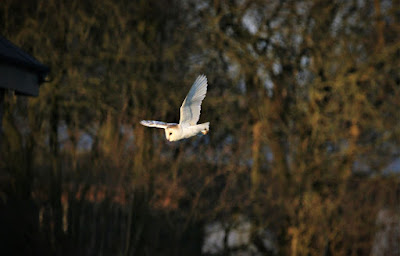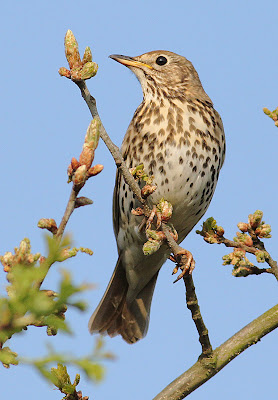“Crisp” might be the best description of the start to Wednesday's birding. At -3º a layer of white frost covered everything in sight at 0730. The several forecasts all agreed, sunshine by midday. This was another day for five or more layers of gear.
There was a good start to the morning with a ghostly Barn Owl along the farm track and then a Great Egret that left the roost with 15/20 Little Egrets.
Barn Owl
The three of us set about our usual routine as we tick-boxed the extra work we now carry out as precautions against HPA1 avian flu - disinfection of all of equipment: nets, bags, pliers, weighing scales and clothing.
The chances of us handling a small passerine with avian flu seem quite remote, especially since the prevalence of HPAI in asymptomatic birds is currently unknown. However, while minimising the risk of transmission should diseased birds be encountered, our continued ringing activities carried out with suitable precautions provide a net benefit in terms of data collection and spotting anything untoward.
As we erected nets we flushed a couple of Snipe from nearby wet areas. This Snipe rush continued through the morning as 20 or more Snipe arrived in ones, twos and threes to feed in areas of grass that remained unfrozen from the overnight temperatures.
The Snipes' arrival coincided with the incoming tide out in Morecambe Bay where the secretive Snipe are common but mostly unseen feeding in salt marsh ditches and pools. The ones we saw had arrived to roost where they would likely stay until the tide receded and darkness fell.
Snipe
Not surprisingly the ringing was off to a slow start with just a couple of birds every now and again. We finished with 14 birds of 7 species: 4 Chaffinch, 3 Linnet, 2 Robin, 1 Blue Tit, 1 Wren, 1 Reed Bunting,1 Greenfinch, 1 Blackbird.
Reed Bunting
Greenfinch
In addition to the earlier Barn Owl and white egrets more to look at arrived in the form of a 'cream top' Marsh Harrier, a Buzzard, and good numbers of Golden Plover, Lapwing & Whooper Swans.
Buzzard
When I went yesterday to drop supplementary seed I counted approximately 400 Whooper Swans out Cockerham way.
Whooper Swans
Stay tuned folks. There's more to come and we are due to get real snow. We'll see.
Linking this week to Eileen's blog and Anni in Texas.






















.jpg)




.png)






.JPG)
















































